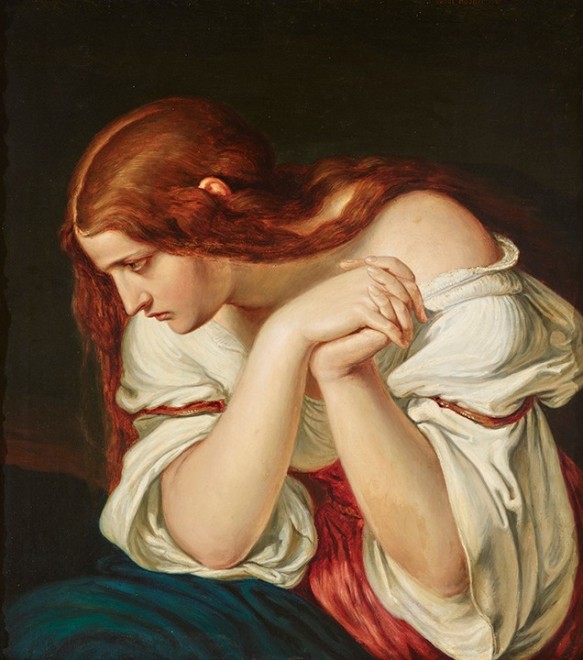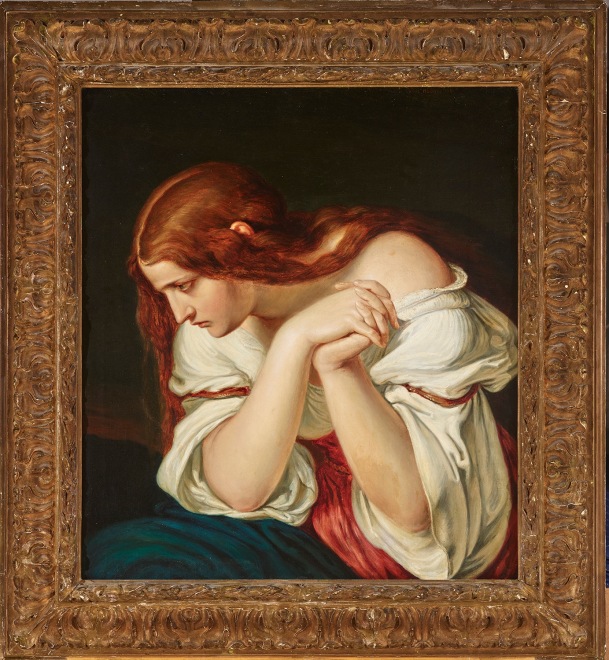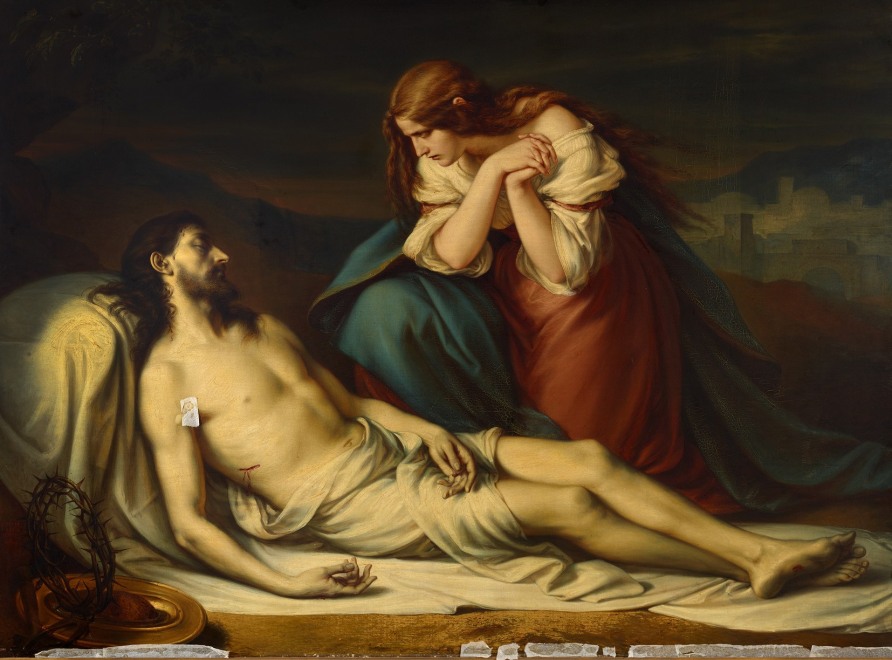Provenance
Sale, Van Ham, Cologne, 16 November 2012, lot 740
Private collection, California (acquired at the above sale)
Exhibited
Berlin, Nationalgalerie, Julius Hübner, 1806-1882, December 1925- January 1926, no. 67, p.16.
Literature
Barbara Dieterich, Verzeichnis der Gemälde und Skulpturen des 19. Jahrhunderts, Nationalgalerie Staatliche Museen Preußischer Kulturbesitz, Berlin 1976, p.181.
Birgid Monschau-Schnittmann, Julius Hübner (1806-1882), Leben und Werk eines Maiers der Spätromantik, Munster 1993, no. 47, pp.43-44 (Magdalene at the Body of Christ, 1859), nos. 47a-47d (sketches and oil studies).
Cordula Grewe, “The Writing on the Wall: Art History, Theories of Civilization, and the Politics of Museum Murals in Nineteenth-Century Germany,” Museum History Journal 5, no. 2, 2012, pp.60-63 and 75 (endnote 58).
Catalogue note
This is sorrow at its deepest. Throughout history, painters had tried their hand at portraits of the Bible’s most notorious sinner, Mary Magdalene; but few have created such an intense depiction of internal feeling, of grief at once spiritual and universal. Excised from a larger historical painting, the close-up replica achieved what the life-size canvas of the Saint’s lamentation over Christ’s body had not: an intimate intensity and intense intimacy.
An integral part of the so-called Schadow circle, Julius Hübner (1806-1882) remained a major representative of his master’s “naturalist idealism” throughout his long career. This was true for a dedication to Schadow’s dictum that portraiture may serve as the foundation of all genres, including history painting. Thus, when the Dresden Academy of Arts appointed Hübner in 1841, he proceeded to export Düsseldorf soul-painting from the Rhine to the Elbe, where he would leave his mark not only as professor but, since 1871, as director of the city’s stupendous Gallery of Paintings as well. But he would remain true to the Nazarene spirit not only in artistic terms. Until the end of his life, Hübner embarked again and again on major projects without aprior commission, choosing subjects strictly for reasons of religious importance and personal identification. His painting, Magdalene at the Body of Christ is a striking case in point (Cat. 5a).The life-size canvas is a late Romantic inflection of Hübner’s uncompromising quest for truth and authenticity, a quest in the name of God that the Lukasbund had elevated so programmatically to Art’s ultimate precept. Finished in 1859, Magdalene at the Body of Christremained in Hübner’s estate until the National Gallery in Berlin acquired the large-format directly from the artist’s heirs in 1888. By then, it had been shown in Dresden, Düsseldorf, Berlin, Cologne and Brussels, and, most prominently, at the World’s Fair in Paris in 1867.
Magdalene at the Body of Christ is a splendid example of Hübner’s mature style and his proclivity to afford the main female protagonists of his biblical stories with an impressive presence. Among Hübner’s strong women, Mary Magdalene nonetheless stands out. She is unusually sensual for a Nazarene, her long reddish hair, which flows in thick locks freely over her bare shoulders is worthy of a Pre-Raphaelite. Quintessentially Nazarene, however, is her composure. Despite the intensity of her anguish, she does not wail. Her hands, wrought togetheras the only physical sign of her inner feelings, are pressed tightly against her body as she crouches down to gaze despairingly into the man stretched out on a white cloth in front of her. Little gives away his identity, and he seems more asleep than dead. The traces of any martyrdom have vanished, and even Christ’s wounds are barely visible. Hübner’s contemporaries picked up on the tension between the sensual depiction of the Savior’s overly relaxed body and a Mary Magdalene almost bursting from the pressure to hold in her pain. Looking at this “picture full of academic studies,” critics lamented that the countenance of the female saint did not correspond with her character, as “it expressed more passionate despair than holy mourning.” Focusing solely on Mary Magdalene’s face, the replica solved this tension with great emotional gain. As we imagine rather than see the body of Christ (now absent), we are invited to identify with one of humanity’s core experiences. The pain shown transcends the biblical scene, thus as our own encounter with tragic loss reflects back onto the biblical scene and helps us to reflect upon its higher meaning.
Excising Mary Magdalene from the narrative, Hübner counted, and rightfully so, on the willingness of an enraptured audience to decode entire narratives solely from a figure’s features. It tied into the success, practiced not least by Wilhelm Schadow himself (1788-1862), to transform simple portrait studies into a kind of devotional genre-painting (see Fig. 14). In 1839, Hermann Püttmann (1811-1874), later instrumental in establishing a German-speaking press in Australia, succinctly summarized the new attitude: “The aestheticians of the old regime loathed bestowing the honored name ‘history’ on representations of the life of the temperament, of the Gemütsleben, which lack chronological leads. In contrast, the new school finds it unjust to dishonor works that reach into the highest regions of the life of the soul, of the Seelenleben, with the superficial name ‘genre.’” Hübner’s portrait of Mary Magdalene strove to reach precisely those highest regions of the soul.
Cat. 5 Figures:
Cat. 5a Julius Hübner, Magdalene at the Body of Christ, oil on canvas, 145 x 198 cm, SMPK, Alte Nationalgalerie, Berlin






